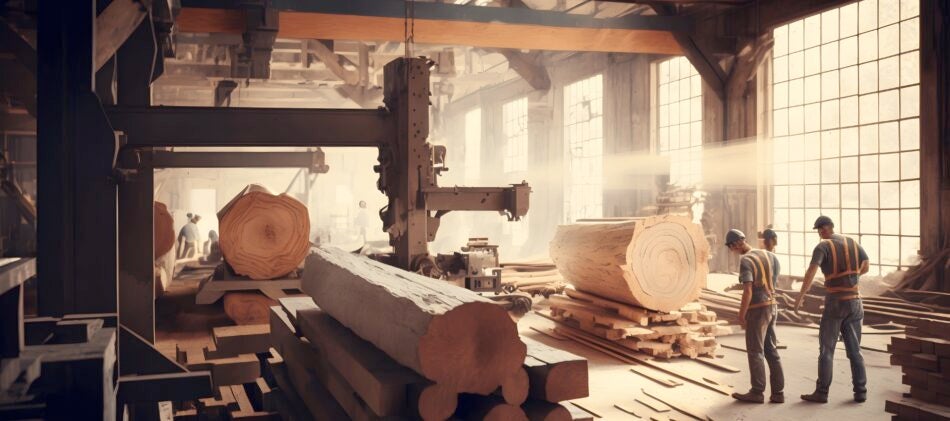Insuring property on an actual cash value (ACV) basis could lead a manufacturing business to permanent close in the event of a large claim. This article will explore the challenges of insuring property on an ACV basis and why we recommend insuring on replacement cost (RC) value instead.
The increasing costs of building materials, construction, labour, inflation and supply chain issues have resulted in rising insurance costs. To reduce insurance premiums, some manufacturing businesses have opted to insure their buildings and equipment on an ACV basis instead of replacement cost (RC). Broadly speaking, ACV is an age depreciation valuation. See Challenge 5 below for a more concise definition. Rather than increasing your deductibles and insuring property on ACV, see our Tips to Reduce Insurance Premiums for better solutions.
An Example:
The following is an example of how ACV and RC translate to insurance premiums for a 50,000 sq ft lumber manufacturing building:
| Replacement Cost | Actual Cash Value |
$10,000,000 Cost per sq ft: $200 Insurance premium: $90,000 Insurance rating: 0.90 | $5,000,000 Cost per sq ft: $100 Insurance premium: $60,000 Insurance rating: 1.20 |
The difference would be $30,000 per year in premiums – but what’s the catch?
Losses happen at the most inconvenient times. Would you have enough cash available to cover the $5 million shortfall? Continue reading, as we examine nine other pitfalls that are important to consider when deciding between ACV and RC.
CHALLENGE 1: CASH RESERVES
With the example above, business owners generally don’t have the shortfall of $5 million sitting in a bank ready to be released when a loss happens. The $30,000 difference in premiums would have to be saved for 166 years annually to make up the shortfall.
CHALLENGE 2: INTERPRETATION
ACV valuations are subject to interpretation. A business owner’s settlement expectations are usually far higher than that of the insurance carrier when a loss occurs.
CHALLENGE 3: BUILDING UPGRADES
Replacing a 50,000 sq ft remanufacturing building with new materials could cost $10 million to $20 million. Owners must consider the plumbing, electrical, heating and fire suppression systems; upgrading to current by-law standards; as well as debris removal. ACV typically doesn’t factor in these costs.
CHALLENGE 4: COST OF PARTIAL LOSSES
Most losses are partial losses. If damage is sustained to 50% of the building, you are likely still operational although at a reduced capacity. Bringing operating capacity back to 100% is essential. The quickest way is to purchase new building materials, equipment and parts rather than searching on the used market.
CHALLENGE 5: CO-INSURANCE CLAUSE
Co-insurance clauses are common on insurance policies and require business owners to insure property and equipment accurately. Co-insurance clauses apply to ACV, and financial penalties occur when owners do not insure to accurate policy limits. Due to differing interpretations, it is likely there will be disagreements with insurance carriers. See “What is Co-Insurance?” to learn more.
CHALLENGE 6: ACV DEFINITIONS
Typically, there are five parameters to accurately insuring to ACV, and each should be considered carefully. Often, only one out of the five are considered:
- The condition of the property or equipment immediately prior to the loss or damage
- The resale value immediately before the loss or damage
- The normal life expectancy
- Obsolescence
- Replacement cost less physical depreciation
CHALLENGE 7: SPEED OF RECOVERY
The downtime following a loss is covered through business interruption insurance, but will your customers wait 12 to 18 months to receive a product? Used equipment in good working order is scarce and finding a replacement is a gamble that might not pay off. Insuring to replacement cost affords you the option to replace old equipment for new, including transportation and installation costs immediately.
CHALLENGE 8: RISK MANAGEMENT
If your RC insurance premium is high compared to others, it’s possible the loss control or risk management doesn’t meet the insurance carrier’s requirements. Insuring property on ACV might provide a false sense of security. ACV will reduce insurance premiums, but doesn’t address concerns around housekeeping, maintenance and operational processes.
CHALLENGE 9: DEBT OBLIGATIONS
Lending services require insurance on your assets to at least replacement cost value. Typically, their terms will include wording such as:
“The Borrower shall keep in force an “All Risks” insurance policy for replacement cost on a stated amount basis with loss made payable firstly to the bank as its interests may appear.”
Non-compliance with your lender’s terms could result in serious consequences.
When to Insure ACV:
ACV makes sense for a business if the property or equipment is not critical to operations and will not be replaced following a total loss. If replacing property or equipment is unnecessary, or there is no motivation to continue business following a loss, then ACV could be the right option.
Insuring property and equipment on an RC valuation is by far the best settlement option when you are faced with a significant insurance claim.
Contact an Acera Insurance risk advisor for more information:
Will Downing
T: 250 869 6096 | E: will.downing@acera.ca

